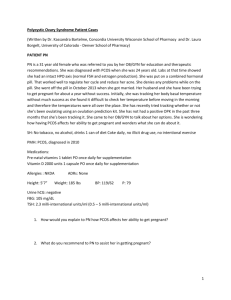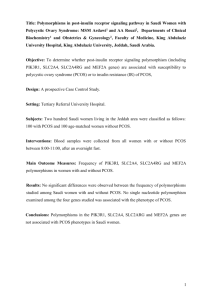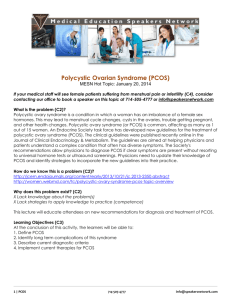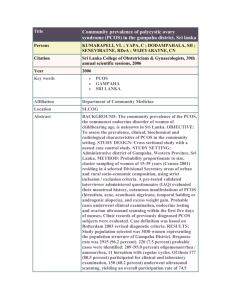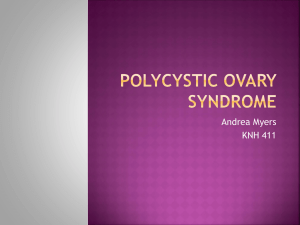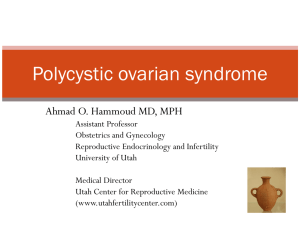Document 14249279
advertisement
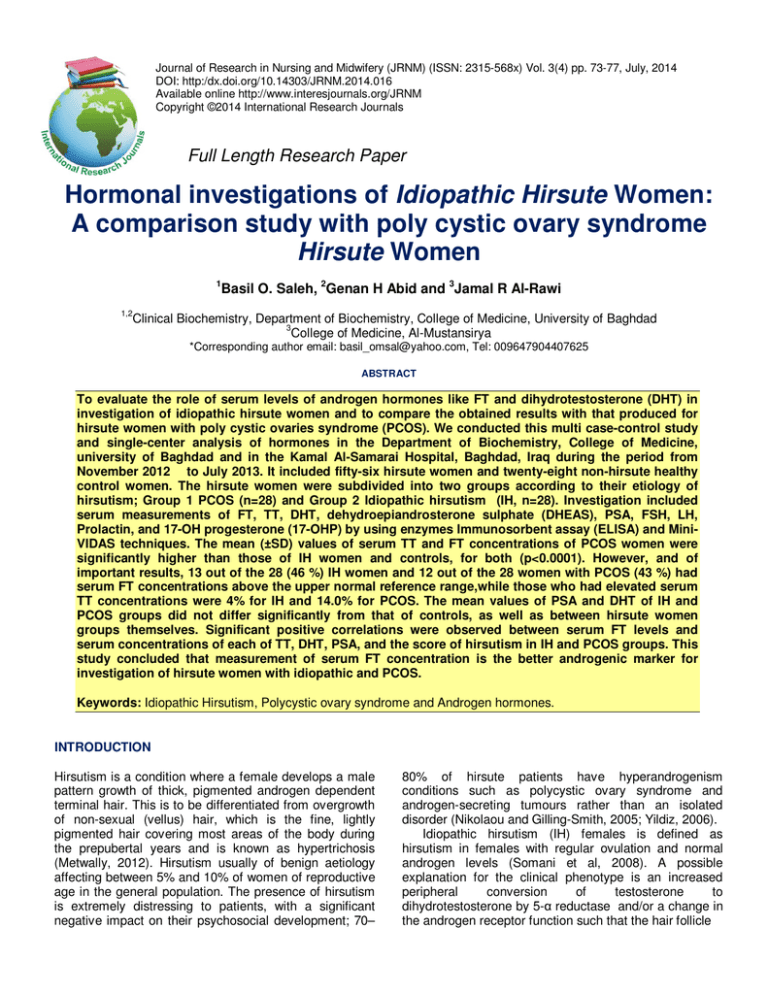
Journal of Research in Nursing and Midwifery (JRNM) (ISSN: 2315-568x) Vol. 3(4) pp. 73-77, July, 2014 DOI: http:/dx.doi.org/10.14303/JRNM.2014.016 Available online http://www.interesjournals.org/JRNM Copyright ©2014 International Research Journals Full Length Research Paper Hormonal investigations of Idiopathic Hirsute Women: A comparison study with poly cystic ovary syndrome Hirsute Women 1 Basil O. Saleh, 2Genan H Abid and 3Jamal R Al-Rawi 1,2 Clinical Biochemistry, Department of Biochemistry, College of Medicine, University of Baghdad 3 College of Medicine, Al-Mustansirya *Corresponding author email: basil_omsal@yahoo.com, Tel: 009647904407625 ABSTRACT To evaluate the role of serum levels of androgen hormones like FT and dihydrotestosterone (DHT) in investigation of idiopathic hirsute women and to compare the obtained results with that produced for hirsute women with poly cystic ovaries syndrome (PCOS). We conducted this multi case-control study and single-center analysis of hormones in the Department of Biochemistry, College of Medicine, university of Baghdad and in the Kamal Al-Samarai Hospital, Baghdad, Iraq during the period from November 2012 to July 2013. It included fifty-six hirsute women and twenty-eight non-hirsute healthy control women. The hirsute women were subdivided into two groups according to their etiology of hirsutism; Group 1 PCOS (n=28) and Group 2 Idiopathic hirsutism (IH, n=28). Investigation included serum measurements of FT, TT, DHT, dehydroepiandrosterone sulphate (DHEAS), PSA, FSH, LH, Prolactin, and 17-OH progesterone (17-OHP) by using enzymes Immunosorbent assay (ELISA) and MiniVIDAS techniques. The mean (±SD) values of serum TT and FT concentrations of PCOS women were significantly higher than those of IH women and controls, for both (p<0.0001). However, and of important results, 13 out of the 28 (46 %) IH women and 12 out of the 28 women with PCOS (43 %) had serum FT concentrations above the upper normal reference range,while those who had elevated serum TT concentrations were 4% for IH and 14.0% for PCOS. The mean values of PSA and DHT of IH and PCOS groups did not differ significantly from that of controls, as well as between hirsute women groups themselves. Significant positive correlations were observed between serum FT levels and serum concentrations of each of TT, DHT, PSA, and the score of hirsutism in IH and PCOS groups. This study concluded that measurement of serum FT concentration is the better androgenic marker for investigation of hirsute women with idiopathic and PCOS. Keywords: Idiopathic Hirsutism, Polycystic ovary syndrome and Androgen hormones. INTRODUCTION Hirsutism is a condition where a female develops a male pattern growth of thick, pigmented androgen dependent terminal hair. This is to be differentiated from overgrowth of non-sexual (vellus) hair, which is the fine, lightly pigmented hair covering most areas of the body during the prepubertal years and is known as hypertrichosis (Metwally, 2012). Hirsutism usually of benign aetiology affecting between 5% and 10% of women of reproductive age in the general population. The presence of hirsutism is extremely distressing to patients, with a significant negative impact on their psychosocial development; 70– 80% of hirsute patients have hyperandrogenism conditions such as polycystic ovary syndrome and androgen-secreting tumours rather than an isolated disorder (Nikolaou and Gilling-Smith, 2005; Yildiz, 2006). Idiopathic hirsutism (IH) females is defined as hirsutism in females with regular ovulation and normal androgen levels (Somani et al, 2008). A possible explanation for the clinical phenotype is an increased peripheral conversion of testosterone to dihydrotestosterone by 5-α reductase and/or a change in the androgen receptor function such that the hair follicle 74 J. Res. Nurs. Midwifery receptors are more sensitive to circulating androgens. Idiopathic hirsutism is often due to an ethnic or familial trait (Brodell and Mercurio, 2010). Approximately 95% of cases of androgen-dependent hirsutism, PCOS, are caused by the combined production of androgen from both the ovaries and the adrenal glands, while IH has been linked with increased enzymatic conversion of testosterone to dihydrotestosterone by 5-alpha reductase in the skin (Azziz et al., 2000). The definition of IH has varied significantly over the past three decades, along with changes in the definition of PCOS, however as IH is a diagnosis of exclusion, it is often difficult to fully differentiate these two disorders (Azziz et al., 2009). There are only a few documented community based studies that have estimated the prevalence of these two conditions (Asuncion et al., 2000; Tehrani et al., 2011). The reported prevalence range of PCOS is between 2.2% to 26% (Tehrani et al., 2011; Mehrabian et al., 2011) and it is estimated that approximately 5% to 20% of hirsute women will have IH (Azziz et al., 2009; Ansarin et al., 2007). The biosynthesis of testosterone begins in the adrenal cortex where cholesterol is converted through a multistep process to dehydroepiandrosterone (DHEA) and androstenedione. It is also produced in smaller amounts by the ovaries in women (Anthony, 2009). The primary androgen responsible for hair growth is dihydrotestosterone (DHT), which is synthesized from testosterone by the activity of 5α-reductase type 2 (Lowenstein, 2006). Periurethral gland was the first female tissue that was suggested to be able to produce PSA (Tepper et al., 1984). Because of the relationship between PSA production and androgen regulation, PSA may be a marker of androgen action in women (Galadari and Alkaabi, 2004). Therefore, the aim of the present study was to evaluate the role of serum measurement of androgen hormones including FT, TT, DHT, DHEAS and PSA in investigation and diagnosis of hirsutism in women with idiopathic (IH) and those with PCOS, to differentiate between these two groups and to discriminate the best androgen hormone marker for assessment of such women. SUBJECTS AND METHODS This study was carried out at Department of Biochemistry, College of Medicine, University of Baghdad, at Kamal AL-Samarai Hospital-Center of Fertility and In vitro Fertilization, Baghdad and at Department of Dermatology and verenology Al- Yarmouk Hospital, Baghdad, Iraq, during the period from November 2012 to July 2013. Formal consent was taken from each subject. We received ethical approval from the Scientific Committee of the Biochemistry Department, College of Medicine, University of Baghdad, Iraq. This study included fifty-Six hirsute women and twenty-eight non-hirsute healthy control women. The hirsute women were subdivided into two groups according to their etiology of hirsutism: Group 1 consisted of 28 women with Polycystic Ovary Syndrome (PCOS) aged 15-40 years and Group 2 included 28 women with Idiopathic hirsutism (IH) aged 19-42 years. Inclusion of IH women was based on exclusion of other causes of hirsutism. Women were considered to have idiopathic hirsutism after excluding of PCOS, Congenital Adrenal Hyperplasia [CAH; by measurement of basal serum 17-hydroxy progesterone, the cut off value is (2 ng/ml)], Cushingʾs syndrome, androgen secretary tumors and thyroid dysfunction. Twenty-eight clinically and biochemically healthy non-hirsute women aged 17-43 years were included as control group. These women were BMI matched with PCOS and IH women. Hirsutism score was determined by the FerrimanGallwey (F-G) scoring system. It is a method of evaluation and quantifying hirsutism, hair growth is rated from 0 (no growth of terminal hair) to 4 (complete and heavy cover), in nine location, giving a maximum score of 36.The nine location measured are the upper lip, chin, chest, upper back, lower back, upper abdomen, lower abdomen, the upper arms and the thighs. Every location gets a score of 0-4.3 Three- five milliliter (ml) of blood sample was aspirated from peripheral vein of each hirsute and healthy women on day (2-3) of their menstrual cycle, allowed to clot for 15 minutes and centrifuged at 3000 rpm within 30 minute to separate the serum that stored in aliquots at 20◦C until the day of the following biochemical parameters measurements: FSH, LH, Prolactin by using Mini-VIDAS technique and TT, FT, DHT, DHEAS, PSA, and 17- OHP by Enzyme Linked Immunosorbent Assay (ELISA) technique, Huma Readers-Germany, Kits were provided by human gesellschaft für biochemica und diagnostica mbh.Wiesbden-Germany. The assay principle of Mini-VIDAS combines an enzyme immunoassay sandwich method with a final fluorescent detection [Enzyme Linked Fluorescent Assay (ELFA)], the kit was provided by (bioMērieux ® sa, France). We used the Statistical Package for Social Sciences (SPSS Inc., Chicago IL, USA) version 15, and Minitab analysis programs (Minitab Inc, version 15, PA, USA) for all statistical studies. We used ANOVA and Student’s t-tests to test for statistical significance. Linear regression was utilized to test for correlation between different studied parameters, and the significance of the r-value was assessed by related t-test. Pvalues of less than 0.05 were considered significant. RESULTS Table 1 shows the mean (±SD) values of serum TT, FT, Saleh et al. 75 Table 1. The (mean ± SD) values of Androgen Hormones investigation in IH, PCOS and controls. Parameter TT (ng/ml) * FT (pg/ml) ** DHT(pg/ml)NS DHEA-S (µg/ml)*** PSA(ng/ml) NS (TT,FT, DHT, DHEA-S and PSA) IH(n=28) 0.41 ±0.95 PCOS (n=28) 0.55± 0.19 Controls (n=28) 0.11± 0.34 3.95 ± 3.48 243.18 ±94.22 1.93± 0.81 0.13 ± 0.12 6.18 ± 6.13 290.27 ± 156.97 2.70 ± 1.45 0.21 ±0.28 1.99 ± 1.55 210.47 ± 96.55 1.91 ± 0.83 0.10 ± 0.07 * t- test, significant difference between PCOS and each of IH and controls for both (p=0.0001) ** t- test, significant difference between PCOS and controls (p<0.0001) *** t- test, significant difference between PCOS and each of IH and controls for both (p=0.009) NS –Non significant Table 2. Percentage of the measured androgen hormones above the normal reference range in women of IH, PCOS and controls. Parameters TT (ng/ml) FT (pg/ml) DHT(pg/ml) DHEA-S (µg/ml) PSA(ng/ml) IH % (n=28) 1(4%) 13(46%) 3(11%) Zero (0%) 4(14%) DHT, DHEA-S and PSA concentrations of IH, PCOS and controls. Table 2 shows the percentage of the measured androgen hormones which are exceeded the upper normal reference range (UNRR) in studied groups. The mean (±SD) value of serum TT concentrations of PCOS women (0.55± 0.19 ng/ml) was significantly higher than that of IH women (0.41±0.95 ng/ml) and controls (0.34±0.11 ng/ml), for both (p<0.0001), while the mean value of TT concentrations of IH women did not differ significantly from that of controls. One women out of 28 IH group (3.6~4%) have serum TT concentration above the UNRR (0.6 ng/ml), while, that of PCOS group was 14.0% (4 out of 28), and of control group was zero % (all within normal range). The mean (±SD) value of serum levels of FT of IH (3.95 ± 3.48 pg/ml) did not differ significantly compared with that of PCOS women (6.18 ± 6.13 pg/ml, p=0.051) and controls (1.99 ± 1.55 pg/ml, p=0.092). However, the mean value of serum levels of FT of PCOS was significant higher than that of controls (p=0.0001). In IH group, 13 out of 28 women had serum FT concentration above the UNRR with percentage (46.43~46%), while, it was 42.8~43%, (12 out of 28 women) in PCOS group. None of the control women had serum FT concentration above the UNRR. The mean values of DHT of IH (243.18 ±94.22 pg/ml) and PCOS (290.27 ± 156.97 pg/ml) groups did not differ significantly from that of controls (210.47 ± 96.55 pg/ml) , as well as between patient groups themselves. Three out of IH group (10.7~11%) and five out of PCOS women PCOS % (n=28) 4(14%) 12(43%) 5(18%) 6(21%) 6(21%) Controls % (n=28) Zero (0%) Zero (0%) Zero (0%) Zero (0%) Zero (0%) (17.8~18.0%) had serum DHT concentration above the UNRR. The mean (±SD) value of serum levels of DHEAS of PCOS (2.70±1.45 µg/ml) was significantly higher than that of IH (1.93 ± 0.81 µg/ml, p=0.009).There was no significant difference in the mean values of DHEA-S between IH and controls (1.91± 0.83 µg/ml), while it was significantly higher in PCOS women in comparison with that of controls (p=0.009). The serum level of DHEA-S was exceeded the UNRR in six out of 28 of PCOS women with percentage (21.4~21%). However, none of IH women and controls had serum DHEA-S concentration above the UNRR (zero %). The mean values of PSA of IH (0.13± 0.12 ng/ml) and PCOS (0.21±0.28 ng/ml) groups did not differ significantly from that of controls (0.10± 0.07 ng/ml) , as well as between hirsute women groups themselves. Four women out of 28 IH group (14.2~14%) had serum PSA concentration more than the UNRR (0.2 ng/ml), while, the percentage of PSA in PCOS group was 21% (6 out of 28), and of control group was zero %. With regard to FSH, LH, and Prolactin levels, there was no significant differences in the levels of these three hormones between the IH and PCOS groups (table 3). In IH women group, there was significant positive correlations observed between the score of hirsutism and each of FT ( r= 0.458, P =0.014) and PSA ( r= 0.556, P = 0.002). There was also significant positive correlations between FT and each of DHT (r=0.696, p=0.0001) , DHEAS (r=0.808, p=0.0001) and PSA (r=0.888, p=0.0001). In PCOS women, significant positive 76 J. Res. Nurs. Midwifery Table 3-3. Mean( ± SD) values of Hormonal investigation (FSH, LH,PR and 17-OH Progesterone) in IH, PCOS and controls. Parameter * FSH (mIU/ml) * LH (mIU/ml) * PRL (ng/ml) * 17-OH Progesterone (ng/ml) IH (n=28) 6.42 ±2.21 5.79 ± 2.59 14.62 ± 5.34 1.26 ± 0.39 PCOS (n=28) 7.12 ± 2.17 6.58 ± 3.67 16.71 ± 8.19 1.31 ±0.37 Controls (n=28) 1.21± 0.54 *Non significant difference in the measured hormones among studies groups. correlations were observed between hirsutism score and each of FT ( r= 0.823, P =0.0001) , DHT ( r= 0.421, P = 0.026) and DHEAS( r= 0.416, P = 0.028) as well as between FT and each of DHT ( r= 0.516, P =0.005) , DHEAS( r= 0.489, P = 0.008). Moreover, there was significant positive correlation between PSA and each of FT(r=0.924, p=0.0001), DHT ( r= 0.633, P =0.0001) and DHEAS( r= 0.554, P = 0.002) in PCOS women. DISCUSSION The mean values of serum concentrations of TT and FT in IH women did not differ significantly from those of controls, table (1) .These results are in agreement with those reported by (Cross et al., 2008) who also did not found significant difference in serum levels of TT between their IH women and controls. However, in PCOS, the mean value of serum TT was significantly higher than that of IH and controls, but the mean of FT was only insignificantly higher than IH (table 2). These results are in agreement with those reported by (Hassa et al., 2005) who found the circulated TT in PCOS group was significantly higher compared to women with IH. A study carried out in Iraq in 2012 conducted by (Shemran, 2012) who found significant increase in the mean value of TT and FT of hirsute female patients in comparison with control group, however, the underlying cause of hirsutism was not differentiated (Cosar et al., 2008). Showed in PCOS, insulin affected the ovary by stimulating the ovarian receptors of the insulin and insulin-like growth factors to enhance androgen production from theca cells, FT is increased due to the inhibition of SHBG synthesis from the liver. The present study revealed that the percentage of women with elevated FT in IH group was 46%, in PCOS 43% , and in controls zero %, While those of TT were 4%, 14% and zero %, respectively .These results reflect that in IH and PCOS the majority of hirsute women have abnormal serum FT levels even in the presence of normal TT . In a study done by (Anfal, 2012) who found serum TT levels was elevated above the upper limit in 45.37% of their PCOS women, while (Najem et al., 2008) in Benghazi-libya found that TT was elevated in 26% of PCOS patients. The percentage of women with elevated DHT in IH was 11%, in PCOS 18% and in controls zero%. DHT is formed and acts as a paracrine/autocrine hormone. Blood level probably provide only a hint of the level in tissues, and this may vary from organ to organ, since a major fraction of peripheral DHT must be metabolized locally prior its appearance in the circulation (Horton, 1992). In PCOS, the mean value of serum DHEAS was significantly higher than that of IH and controls, while there was no significant difference between IH and control (table 2). These results are in agreement with those reported by (Hassa et al., 2005) who found the circulated DHEA-S was significantly higher in the PCOS group compared to women with IH. The percentage of women with elevated DHEA-S in IH was zero %, in PCOS 6% and in controls zero. These result are consistent to study done by (Horton, 1992) who concluded that DHEAS was not found to be clinically helpful in assessment of hirsute women. The present study showed that the mean of serum PSA of IH did not differ significantly from that of controls. This result is similar to that reported by (Galadari and Alkaabi, 2004) who found PSA was detected at very low concentrations in hirsute women. In addition, in PCOS, the mean PSA value was also comparable with that of controls and IH women. However, these latter result was disagree with that reported by (Hussain and Rzaij 2012) who found the mean value of serum PSA in patients with PCOS was significantly elevated when compared with the normal control group. In conclusion, this study found that measurement of serum FT concentration is the better androgenic marker for investigation of hirsute women with idiopathic and PCOS causes. Several alternative hormonal investigation like serum TT and DHEAS could be used in assessment of PCOS, but not idiopathic hirsute women. Limitation of this study is inability to investigate intracellular DHT concentrations. Future studies are recommended for measurements of DHT concentrations in hair, SHBG concentrations and menstrual cycle phase dependent level of PSA. REFERENCES Anfal AJ (2012). Impact of obesity on the incidence of Polycystic Ovary Syndrome in some Iraqi female Saleh et al. 77 patients. A thesis in Iraqi Board pathol.-Chem. Pathol.-Iraqi Board for Med Special. 50-60. Ansarin H, Aziz-Jalal MH, Rasi A (2007). Clinical presentation and etiologic factors of hirsutism in premenopausal Iranian women. Arch Iran Med. 10: 7-13. Anthony WP (2009). The Diversity of the endocrine system. In: Murray RK, Bender DA, Botham KM, Kennekky PJ, Rodwell VW, Anthony Weil P (Editors). Harper's Illustrated Biochemistry. 28th Edition. Chapter 41. McGraw-Hill: New York. Asuncion M, Calro RM, San Millan JL, (2000). A prospective study of the prevalence of the polycystic ovary syndrome in unselected Caucasian women from Spain. J. Clin. Endocrinol. Metab. 85: 24342438. Azziz R, Carmina E, Sawaya ME (2009). The Androgen Excess and PCOS Society criteria for the polycystic ovary syndrome: the complete task force report. Fertil Steril. 91: 456-488. Azziz R, Carmina E, Dewailly D (2000). Idiopathic hirsutism. Endocr. Rev. 21: 347–62. Brodell LA, Mercurio MG (2010). Hirsutism: Diagnosis and Management. Gender Med. 7(2): 79-87. Cosar E, Koken G, Sahin FK (2008). Insulin sensitivity does not differentiate by hirsutism in non-obese women with polycystic ovary syndrome. Endocr. J. 55(3): 465-8. Cross G, Danilowicz K, Kral M (2008). Sex hormone binding globulin decrease as a potential pathogenetic factor for hirsutism in adolescent girls. Med. (B Aires). Pp. 68:120. Galadari M, Alkaabi j (2004). Prostatic-specific antigen and idiopathic hirsutism in females. Int. J. Dermatol. 43: 275–277. Galadari M, Alkaabi j (2004). Prostatic-specific antigen and idiopathic hirsutism in females. Int J. Dermatol. 43: 275–277. Hassa H, Tonir HM, Yildirim A (2005). The hirsutism scoring system should be population specific. Fertil. Steril. Pp. 84:778. Horton R (1992). Dihydrotestosterone Is a peripheral paracrine. J. Androl. 13(1): 23-27. Hussin N K, Rzaij ZF (2012). Evalution of PSA tumor marker in some Iraqi women with Polycystic Ovarian Syndrome.Iraqi J. Embryos and Infertil. Res. 2(4): 22-24. Lowenstein EJ (2006). Diagnosis and management of the dermatologic manifestations of the polycystic ovary syndrome. Dermatol. Ther. 19: 210–23. Mehrabian F, Khani B, Kelishadi R, Ghanbari E (2011). The prevalence of polycystic ovary syndrome in Iranian women based on different diagnostic criteria. Endokrynol. Pol. 62(3): 238-42. Metwally MH (2012). Obstetr. Gynaecol. Reproduct. Med. 22(8): 211214. Najem FI, Elmehdawi RR, Swalen AM (2008). Clinical and Biochemical characteristic of polycystic ovary syndrome in Benghazi;Aretrospective study,Libyan J. Med. 3(2): 71-74 Nikolaou D, Gilling-Smith C (2005). Hirsutism. Cur Obstetr. Gynecol. 15: 174–82. Shemran KA (2012). Total, Free Testosterone and insulin hormone level in patient with hirsutism. 9(2): 307-312. Somani N, Harrison S, Bergfeld WF (2008). The clinical evaluation of hirsutism. Dermatol. Ther. 21: 376–391. Tehrani FR, Simbar M, Tohidi M (2011). The prevalence of polycystic ovary syndrome in a community sample of Iranian population: Iranian PCOS prevalence study. Reprod. Biol. Endocrinol. Pp. 9:39. Tepper S, Lagirdar J, Heath D, Geller SA (1984). Homology between the female Paraurethral (Skene s) glands and prostate. Immunohistochemical demonstration. Arch. Pathol. Lab. Med. 108: 423-25. Willenberg HS, Bahlo M, Schott M (2008). Helpful diagnostic markers of steroidogenesis for defining hyperandrogenemia in hirsute women. Steroids. 73(1): 41-6. Yildiz BO (2006). Diagnosis of hyperandrogenism: clinical criteria. Best Pract. Res. Clin. Endocrinol. Metab. 20: 167–76. How to cite this article: Saleh B.O, Abid G.H. and Al-Rawi J.R (2014). Hormonal investigations of Idiopathic Hirsute Women: A comparison study with poly cystic ovary syndrome Hirsute Women. J. Res. Nurs. Midwifery 3(4):7377

